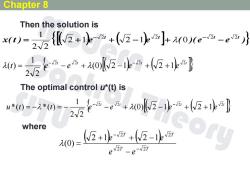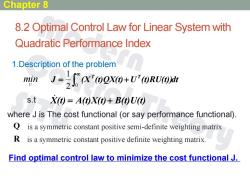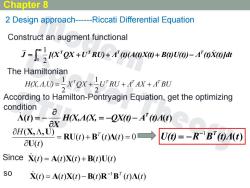上海交通大学:《现代控制理论》课程教学资源(讲稿)Chapter 8 Fundamentals of Optimal Control

Chapter 8 2 Chapter 8 Fundamentals of Optimal Control Objectives: Optimal control from Hamilton-Pontryagin Equation Optimal Control Law for Linear System with Quadratic Performance Index Design procedure and examples
Chapter 8 Fundamentals of Optimal Control Objectives: • Optimal control from Hamilton-Pontryagin Equation • Optimal Control Law for Linear System with Quadratic Performance Index • Design procedure and examples Chapter 8 2

Chapter 8 8.1 Optimal Control based on Hamilton-Pontryagin Equation 1.The optimal control problem for feedback control systems. To minimize J=L(X.U)d subject to X(t)=f(X,U) TU X)e∈R" state vector U(t)∈R' the control vector f(X,U) the function vector(Rn+r-R) L(X,U) Rnr→Rn,J is a function 2.Target: Euler-Lagrange Equation>Hamilton-Pontryagin Equation
8.1 Optimal Control based on Hamilton-Pontryagin Equation 1.The optimal control problem for feedback control systems. To minimize T J L X U dt 0 ( , ) subject to X(t) f(X,U) state vector n X(t)R r U(t)R f(X, U) L(X,U) the control vector the function vector(Rn+r→Rn ) Rn+r→Rn , J is a function 2.Target: Euler-Lagrange Equation Hamilton -Pontryagin Equation Chapter 8

Chapter 8 3.The design approach Step 1.Rewrite the state equation -X(t)+f(X(t),U(t)=0 Step 2.Set up the augment functional J[L(X,U)+A"(f(X,U)-x)]dt =L(X,U)+A"f-A"x)]dt Define: F=L(X,U)+Af(X,U)-A'X Step 3.Define a scalar function-Hamiltonian H(X,U,A)=L(X,U)+A'f(X,U) then F=H(X,U,A)-A"X
3.The design approach Step 1. Rewrite the state equation X(t) f(X(t),U(t)) 0 Step 2. Set up the augment functional T T T T T L dt J L dt 0 0 [ ( , ) )] [ ( , ) ( ( , ) )] X U Λ f Λ X X U Λ f X U X Define: X U Λ T f X U Λ T X F L( , ) ( , ) Step 3. Define a scalar function —Hamiltonian (X,U, Λ) (X,U) Λ f(X,U) T H L then F H X U Λ Λ T X ( , , ) Chapter 8

Chapter 8 Step 4.Applying Euler-Lagrange Equation to this problem OF d oF 0 dt ox OF d =00 aU d而 OF d oF =0 an dt a Step 5.By substituting into the equation above aH(X,A,U)d=0 Furthermore OH 1(0= OX dt ox aH(X,A,U) 0 OH =0 aU aU F(&,A,U,X-0 X=fX,U) aA Hamilton-Pontryagin equation------The necessary condition for optimizing control systems
Step 4. Applying Euler-Lagrange Equation to this problem 0 0 0 Λ Λ U U X X F dt F d F dt F d F dt F d Step 5. By substituting into the equation above 0 ( , , , ) 0 ( , , ) 0 ( , , ) Λ X Λ U X U X Λ U Λ X X Λ U F H dt H d Furthermore X f(X,U) U H X H Λ(t) 0 Hamilton-Pontryagin equation------The necessary condition for optimizing control systems. Chapter 8

Chapter 8 Example Consider the optimal control problem Min J+(dr s.t (t)=-x(t)+u(t) boundary condition x(0)=1,x(T)=0 Our task:To find the optimal control law u*(t). Step 1.Rewrite the equation as -x(t)+(-x(t)+u(t)=0 Step 2.Set up the augment functional J-r++ex*- eory Step 3.Write Hamiltonian 2+2-x+ H=x 2 2
Example Consider the optimal control problem Min T J x t u t dt 0 2 2 ( ( ) ( )) 2 1 s.t x (t) x(t) u(t) boundary condition : x(0)=1, x(T)=0 Our task: To find the optimal control law u*(t). Step 1. Rewrite the equation as x (t) x(t) u(t) 0 Step 2. Set up the augment functional T J x u x u x dt 0 2 2 ( )] 2 1 2 1 [ Step 3. Write Hamiltonian H x u x u 2 2 2 1 2 1 Chapter 8

Chapter 8 Step 4.From H-P equation,we have (t)=-x(t)+(t) u(t)+2()=0 heory x(t)=-x(t)+u(t) Above equation set can be rewritten as Step 5.Solve the equation --1=0 A-n=-11- The characteristic is .2=2
Step 4. From H-P equation, we have ( ) ( ) ( ) ( ) ( ) 0 ( ) ( ) ( ) x t x t u t u t t t x t t Above equation set can be rewritten as ( ) ( ) 1 1 1 1 ( ) ( ) t x t t x t Step 5. Solve the equation 0 1 1 1 1 A I The characteristic is 1,2 2 Chapter 8

Chapter 8 Then the solution is w=222++(-火]20e-e} 2025-e+05-+5+】 The optimal control u*(t)is 0=-2m7对卡-g+40k55 where 20-2++柜-业 -e-27
Then the solution is x( t ) e e ( )( e e ) 2t 2t 2t 2t 2 1 2 1 0 2 2 1 t t t t t e e e e 2 2 2 2 (0) 2 1 2 1 2 2 1 ( ) The optimal control u*(t) is t t t t u t t e e e e 2 2 2 2 (0) 2 1 2 1 2 2 1 *( ) *( ) where T T T T e e e e 2 2 2 2 2 1 2 1 (0) Chapter 8

Chapter 8 8.2 Optimal Control Law for Linear System with Quadratic Performance Index 1.Description of the problem min JQX+RU s.t X(t)=A(t)X(t)+B(t)U(t) where J is The cost functional(or say performance functional) Q is a symmetric constant positive semi-definite weighting matrix R is a symmetric constant positive definite weighting matrix. Find optimal control law to minimize the cost functional J
8.2 Optimal Control Law for Linear System with Quadratic Performance Index 1.Description of the problem J (X (t)QX(t) U (t)RU(t))dt T T 2 0 1 s.t X(t) A(t)X(t) B(t)U(t) where J is The cost functional (or say performance functional). Q is a symmetric constant positive semi-definite weighting matrix R is a symmetric constant positive definite weighting matrix. Find optimal control law to minimize the cost functional J. min U Chapter 8

Chapter 8 2 Design approach------Riccati Differential Equation Construct an augment functional JXX+URU(AX+BU()-d The Hamiltonian HA-OURU+U According to Hamilton-Pontryagin Equation,get the optimizing condition 入(0= HX,A(X,=-OX(-AA(t) Ox HX,A,心=RU0+B'(O0=0→U@=-RB(0M( au(t) Since x(t)=A(t)X(t)+B(t)U(t) so X(t)=A(t)X(t)-B(t)R-B'(t)A(t)
2 Design approach------Riccati Differential Equation Construct an augment functional J [(X QX U RU) Λ (t)(A(t)X(t) B(t)U(t)) Λ (t)X(t)]dt T T T T 0 2 1 The Hamiltonian 1 1 2 2 T T T T H(X,Λ,U) X QX U RU Λ AX Λ BU According to Hamilton-Pontryagin Equation, get the optimizing condition Λ( ) H(X,Λ(X, QX(t) A (t)Λ(t) X t T ( ) ( ) ( ) 0 ( ) ( ) t t t t H T RU B Λ U X, ,U X(t) A(t)X(t) B(t)U(t) Since so ( ) ( ) ( ) ( ) ( ) ( ) 1 t t t t t t T X A X B R B Λ U(t) R B (t)Λ(t) 1 T Chapter 8

Chapter 8 Suppose A(t)=P(t)X(t) P(t)Eh(n,n) From H-P equation,we have P(t)X(t)+P(t)X(t)=-QX(t)-A"(t)P(t)X(t) U(t)=-R-B'(t)P(t)X(t) X(t)=A(t)X(t)-B(t)R-B"(t)P(t)X(t) Through substituting {P()+P(t)[A(t)-B()R-B'()P(OX)=(-Q-AT(IP(t)X() The Riccati Differential Equation -P(t)=P(t)A(t)+A"(t)P(t)-P(t)B(t)RB'(t)P(t)+
Suppose Λ(t) P(t)X(t) P(t)(n, n) From H-P equation, we have (t) (t) (t) (t) (t) (t) (t) (t) T P X P X QX A P X ( ) ( ) ( ) ( ) 1 t t t t T U R B P X (t) (t) (t) (t) (t) (t) (t) T X A X B R B P X 1 Through substituting (t) (t)[ (t) (t) (t) (t) (t) ( (t) (t)) (t) T T P P A B R B P X Q A P X 1 P t P t A t A t P t P t B t R B t P t Q T T ( ) ( ) ( ) ( ) ( ) ( ) ( ) ( ) ( ) 1 The Riccati Differential Equation Chapter 8
按次数下载不扣除下载券;
注册用户24小时内重复下载只扣除一次;
顺序:VIP每日次数-->可用次数-->下载券;
- 上海交通大学:《现代控制理论》课程教学资源(讲稿)Chapter 7 State Feedback and State Estimator.pdf
- 上海交通大学:《现代控制理论》课程教学资源(讲稿)Chapter 6 Controllability and Observability.pdf
- 上海交通大学:《现代控制理论》课程教学资源(讲稿)Chapter 5 Stability Analysis.pdf
- 上海交通大学:《现代控制理论》课程教学资源(讲稿)Chapter 4 State Space Solutions and Realizations.pdf
- 上海交通大学:《现代控制理论》课程教学资源(讲稿)Chapter 3 Linear algebra.pdf
- 上海交通大学:《现代控制理论》课程教学资源(讲稿)Chapter 2 Mathematic Description of Systems.pdf
- 上海交通大学:《现代控制理论》课程教学资源(讲稿)Chapter 1 Introduction Morden Control Theory(主讲:鲍其莲).pdf
- 上海交通大学:《精密仪器设计》课程教学大纲(电气信息类测控技术与仪器专业).docx
- 兰州交通大学:《电气化铁道供电系统与设计》课程教学资源(教案讲义,打印版)电气化铁道供电系统的构成.pdf
- 兰州交通大学:《电气化铁道供电系统与设计》课程教学资源(教案讲义)高速电气化铁路接触网.pdf
- 兰州交通大学:《电气化铁道供电系统与设计》课程教学资源(教案讲义)铁道供电系统保护及远动控制.pdf
- 兰州交通大学:《电气化铁道供电系统与设计》课程教学资源(教案讲义)铁道供电系统的仿真研究及其智能测试.pdf
- 兰州交通大学:《电气化铁道供电系统与设计》课程教学资源(教案讲义,打印版)电气化铁道供电系统的供电方式(负责人:李彦哲).pdf
- 兰州交通大学:《电气化铁道供电系统与设计》课程教学资源(教案讲义,打印版)铁道供电系统的绝缘水平及防雷接地措施.pdf
- 兰州交通大学:《电气化铁道供电系统与设计》课程教学资源(教案讲义,打印版)电气化铁道供电系统的牵引变电所.pdf
- 兰州交通大学:《电气化铁道供电系统与设计》课程教学资源(实验指导)供电技术知识——中央信号回路.pdf
- 兰州交通大学:《电气化铁道供电系统与设计》课程教学资源(实验指导)供电技术知识——断路器的控制回路.pdf
- 兰州交通大学:《电气化铁道供电系统与设计》课程教学资源(实验指导,打印版)绝缘油耐压实验.pdf
- 兰州交通大学:《电气化铁道供电系统与设计》课程教学资源(实验指导,打印版)介质损耗角的测量.pdf
- 兰州交通大学:《电气化铁道供电系统与设计》课程教学资源(实验指导,打印版)测量绝缘电阻和吸收比.pdf
- 华东理工大学:《信号与系统》课程教学资源(试卷习题)模拟试题1试题.pdf
- 华东理工大学:《信号与系统》课程教学资源(试卷习题)模拟试题1参考答案.pdf
- 华东理工大学:《信号与系统》课程教学资源(试卷习题)模拟试题2参考答案.pdf
- 华东理工大学:《信号与系统》课程教学资源(试卷习题)模拟试题2试题.pdf
- 华东理工大学:《信号与系统》课程教学资源(试卷习题)样题1试题.pdf
- 华东理工大学:《信号与系统》课程教学资源(试卷习题)样题1答案.pdf
- 华东理工大学:《信号与系统》课程教学资源(试卷习题)样题2试题.pdf
- 华东理工大学:《信号与系统》课程教学资源(试卷习题)样题2答案.pdf
- 华东理工大学:《信号与系统》课程教学资源(习题解答)第1章 信号与系统.pdf
- 华东理工大学:《信号与系统》课程教学资源(习题解答)第2章 连续系统的时域分析.pdf
- 华东理工大学:《信号与系统》课程教学资源(习题解答)第3章 离散系统的时域分析.pdf
- 华东理工大学:《信号与系统》课程教学资源(习题解答)第4章 连续系统的频域分析.pdf
- 华东理工大学:《信号与系统》课程教学资源(习题解答)第5章 连续系统的s域分析.pdf
- 安徽理工大学:《智能控制及仿真》课程教学大纲 Intelligent Control Theory and simulation(负责人:陈静).pdf
- 安徽理工大学:《智能控制及仿真》课程教学资源(课件讲义)第2章 专家控制.pdf
- 安徽理工大学:《智能控制及仿真》课程教学资源(课件讲义)第1章 绪论(负责人:陈静).pdf
- 安徽理工大学:《智能控制及仿真》课程教学资源(课件讲义)第3章 模糊控制的理论基础.pdf
- 安徽理工大学:《智能控制及仿真》课程教学资源(课件讲义)第4章 模糊控制.pdf
- 安徽理工大学:《智能控制及仿真》课程教学资源(课件讲义)第5章 自适应模糊控制.pdf
- 安徽理工大学:《智能控制及仿真》课程教学资源(课件讲义)第6章 神经网络的理论基础.pdf
